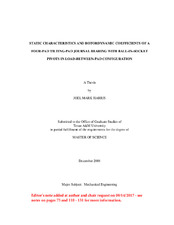| dc.description.abstract | Static characteristics and rotordynamic coefficients were experimentally
determined for a four-pad tilting-pad journal bearing with ball-in-socket pivots in loadbetween-
pad configuration. A frequency-independent [M]-[C]-[K] model fit the
measurements reasonably well, except for the cross-coupled damping coefficients. Test
conditions included speeds from 4,000 to 12,000 rpm and unit loads from 0 to 1896 kPa
(0 to 275 psi).
The test bearing was manufactured by Rotating Machinery Technology (RMT),
Inc. Though it has a nominal diameter of 101.78 mm (4.0070 in.), measurements
indicated significant bearing crush with radial bearing clearances of 99.6 μm (3.92 mils)
and 54.6 μm (2.15 mils) in the axes 45º counterclockwise and 45º clockwise from the
loaded axis, respectively. The pad length is 101.6 mm (4.00 in.), giving L/D = 1.00.
The pad arc angle is 73º, and the pivot offset ratio is 65%. The preloads of the loaded
and unloaded pads are 0.37 and 0.58, respectively.
A bulk-flow Navier-Stokes model was used for predictions, using adiabatic
conditions for the bearing fluid. Because the model assumes constant nominal
clearances at all pads, the average of the measured clearances was used as an estimate.
Eccentricities and attitude angles were markedly under predicted while power loss was
under predicted at low speeds and very well predicted at high speeds. The maximum detected pad temperature was 71ºC (160ºF) and the rise from inlet to maximum bearing
temperature was over predicted by 10-40%.
Multiple-frequency force inputs were used to excite the bearing. Direct stiffness
and damping coefficients were significantly over predicted, but addition of a simple
stiffness-in-series model substantially improved the agreement between theory and
experiment. Direct added masses were zero or negative at low speeds and increased
with speed up to a maximum of about 50 kg; they were normally greater in the unloaded
direction. Although significant cross-coupled stiffness terms were present, they always
had the same sign. The bearing had zero whirl frequency ratio netting unconditional
stability over all test conditions. Static stiffness in the y direction (obtained from steadystate
loading) matched the rotordynamic stiffness Kyy (obtained from multiple-frequency
excitation) reasonably at low loads but poorly at the maximum test load. | en |


